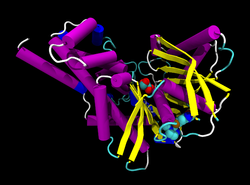Glucokinase
| Glucokinase | ||
|---|---|---|

|
||
| Ribbon model of human glucokinase with glucose and activator MRK as spherical caps , according to PDB 3F9M | ||
| Properties of human protein | ||
| Mass / length primary structure | 465 amino acids | |
| Isoforms | 3 | |
| Identifier | ||
| Gene name | GCK | |
| External IDs | ||
| Enzyme classification | ||
| EC, category | 2.7.1.2 , kinase | |
| Response type | Phosphorylation | |
| Substrate | D -glucose + ATP | |
| Products | D -glucose-6-phosphate + ADP | |
| Occurrence | ||
| Homology family | Glucokinase | |
| Parent taxon | Euteleostomi | |
Glucokinase (GCK) (Hexokinase IV) is the name of an enzyme from the group of hexokinases that phosphorylates D- glucose to glucose-6-phosphate in vertebrates (along with other hexoses) .
There are three isoforms of the enzyme in humans ; This initiates the storage of sugar in the form of glycogen in the liver ; In the pancreas , the reaction regulates the release of insulin . Mutations in the GCK gene can cause a special form of early diabetes ( MODY 2) and congenital hypoglycaemia (HHF3).
Other hexokinases (which accept other hexoses as a substrate, EC 2.7.1.1 ) are located in the brain, muscles, eyes, kidneys and intestines.
function
When entering glycolysis , glucose (Glc) is phosphorylated at the C6 atom to glucose-6-phosphate (G-6P). For the catalysis of this reaction, there are several enzymes hexokinases and glucokinase. Glucokinase can only be found in the liver (hepatocytes) and β- cells of the pancreas , in the rest of the body the phosphorylation of glucose is carried out by the hexokinases.
Hexokinases
The hexokinases bind glucose with high affinity corresponding to a K m value of 0.01 mM and can be inhibited by their end product. In erythrocytes , the intermediate 2,3-diphosphoglycerate formed by the enzyme bisphosphoglycerate mutase in the Rapoport-Luebering cycle , a bypass route to glycolysis, also functions as an inhibitor of hexokinases.
Due to the low Km value, the hexokinases work in the saturation range with regard to glucose both at a blood glucose concentration of 4 mmol / l in the post-absorption phase and at 8-10 mmol / l glucose in the absorption phase. The hexokinases thus have a K m value for glucose which is far below the lowest blood glucose concentration. This ensures that muscles, brain etc. can smuggle in glucose from the blood into glycolysis if necessary, regardless of the metabolic situation.
Glucokinase
The glucokinase has a lower affinity, its Km value is in the range of the serum glucose concentration, it cannot be inhibited by G-6P and shows (positive) cooperative binding behavior. This is critical to their role in the pancreas' blood sugar sensing system .
The regulation of the glucokinase takes place through reversible complexation with the glucokinase regulator protein (GkRP). Binding is stimulated by fructose-6-phosphate and sorbitol-6-phosphate , but hindered by fructose-1-phosphate . The latter thus increases the glucokinase activity. After translocation into the nucleus, the complex is separated when the glucose level is high and the glucokinase is returned to the cytosol.
comparison
The following figure compares the saturation curves of glucokinase and hexokinase
Figure: Glucose saturation curves for hexokinase (yellow upper hyperbola corresponding to Km = 0.01 mM) and a hypothetical kinase with Km = 5.5 mM (yellow, flat lower hyperbola). The glucokinase of the pancreas follows the measuring points between these extremes, it has the following cooperativity parameters according to Hill: Km (av) = 5.5 mM (mean Michaelis constant); nH = 3 (Hill coefficient); The area highlighted in blue indicates the fluctuation range of the blood sugar concentration, i. H. the blood glucose.
The curve of the glucokinase accordingly shows a linear course in the range of physiological blood sugar concentrations, i. H. if Glc rises, proportionally more Glc is converted into G-6P and withdrawn from the bloodstream.
Recently, through the systematic screening of synthetic compounds, an activator (RO-28-1675) of glucokinase was discovered that acts on both liver and pancreatic enzymes. This could enable a new therapy principle for diabetes mellitus (type 2).
Individual evidence
- ↑ Swiss Institute of Bioinformatics (SIB): PROSITE documentation PDOC00370. Hexokinases. Retrieved September 20, 2011 .
- ↑ UniProt entry
- ^ Scott Goodman: Carbohydrate Metabolism. In: kumc.edu. University of Kansas, 1999, accessed October 20, 2019 .
- ^ Sigurd Lenzen: A Fresh View of Glycolysis and Glucokinase Regulation: History and Current Status. In: Journal of Biological Chemistry. 289, 2014, p. 12189, doi : 10.1074 / jbc.R114.557314 .
- ↑ Liu F, Dong Q, Myers AM, Fromm HJ: Expression of human brain hexokinase in Escherichia coli: purification and characterization of the expressed enzyme . In: Biochem. Biophys. Res. Commun. . 177, No. 1, May 1991, pp. 305-11. PMID 2043117 .
- ↑ Palma F, Agostini D, Mason P, et al : Purification and characterization of the carboxyl-domain of human hexokinase type III expressed as fusion protein . In: Mol. Cell. Biochem. . 155, No. 1, February 1996, pp. 23-9. PMID 8717435 .
- ↑ reactome.org: Negative Regulation of Glucokinase by Glucokinase Regulatory Protein



